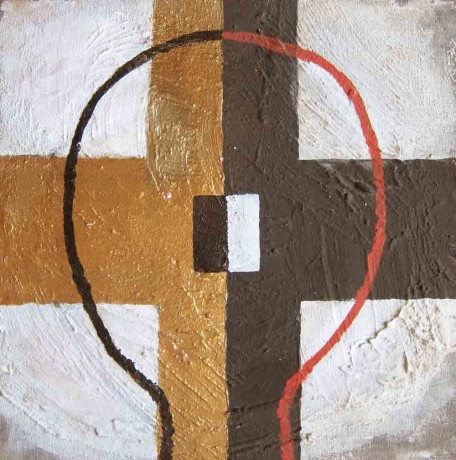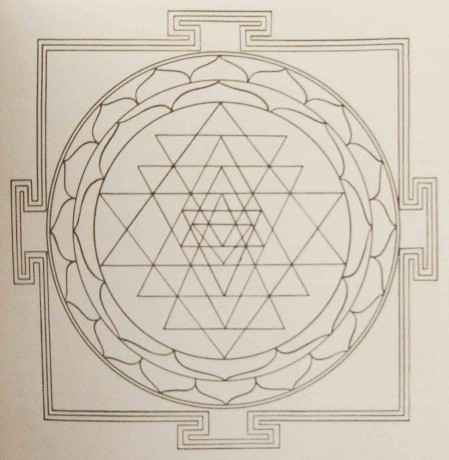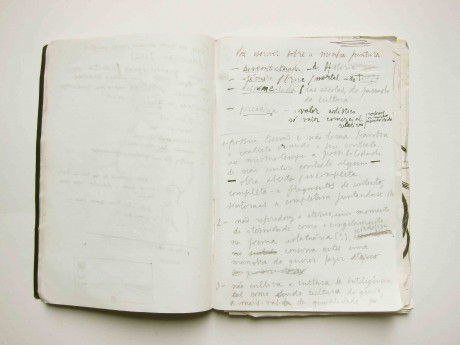O INCONSCIENTE E OS SÍMBOLOS
Símbolo
1999-2016
acrílico sobre tecido montado em madeira
25,5 x 25, 5 cm
– a linguagem como sistema de Símbolos e corpo de signos;
– ideologias e metáforas das contra–ideologias: sonho ou loucura ≠ realidade ideológica;
– os Símbolos tal como os sonhos são naturais – criação orgânica, material: acto espontâneo;
– construção de objectos naturais separados;
– criação / constituição de Símbolos de objectos naturais;
– extrema importância da inteligência artística para:
– leitura de Símbolos artísticos;
– participação simbólica com devolução simbólica ou criativa pelo Símbolo;
– função apelativa.
Gostaria de começar por expor uma definição de Símbolo de interesse vital – o Símbolo tal como nos apresenta a psicanálise de Jung que se opôs em vários e fortes termos à psicanálise freudiana, esta baseando-se em pulsões inconscientes que respondem a fantasmas sexuais originados na infância. Jung apresentou o Inconsciente como campo mais vasto e dividiu-o em Inconsciente pessoal e Inconsciente colectivo – este último é uma propensão psíquica para um funcionamento regular, independente do tempo, do espaço, da raça, detendo a chave do reconhecimento humano (entre humanos) respondendo a arquétipos, fontes e origens de representações originárias e primordiais. São estes arquétipos que permitem reconhecer um Símbolo como entidade colectiva, como entidade comunicante.
O Símbolo e a simbologia são algo que está nas profundezas do nosso ser – a nossa capacidade de comunicar é simbólica mas quando assumida essa comunicação simbólica transforma-se em modo de conhecer, de investigar, de saber, comunicando o Inconsciente e o consciente com a colectividade consciente e vivida no quotidiano – tudo isto para falar num progressivo alargamento da consciência cuja utilidade falarei mais adiante. A isto se liga o pensamento que não quer dar nome (quando dar nome, rotular, catalogar é algo de convencional e arbitrário), quer apenas servir-se da voz – quer permitir que a realidade se manifeste livremente e não segundo categorias nominais, quer exprimir directamente e sem o filtro da razão, tal como acontece nos sonhos e na arte – o imprevisível não tem de justificar-se, tem de ser entendido a uma luz mais vasta, existe de tão pleno direito como o que é previsível.
A voz que se manifesta livremente exprime-se simbolicamente e é uma voz arquetípica, ancestral, que existe desde sempre. “Os Símbolos mais importantes” diz Jung “não são individuais mas colectivos na sua natureza e origem”, “são representações colectivas, datando de épocas remotas e estas são “revelações” só no sentido em que são imagens originadas em sonhos e fantasias criativas. São manifestações espontâneas, involuntárias e de modo nenhum se podem considerar invenções intencionais e arbitrárias”. Assim, uma das primeiras características dos símbolos parece ser a sua espontaneidade que aponta não para o que já se conhece, mas para o que ainda não se conhece.
Uma Mandala
Um outro aspecto dos Símbolos parece ser, ainda na psicanálise jungiana, o de ambivalência. Jung alertou para a “potencialidade de conteúdos do Inconsciente”, para o seu “carácter indeterminado”, para a sua “multidão de significações”. O Inconsciente pode determinar para um único objecto uma infinidade de significações. Assim ele atribui a uma coisa um significado ao mesmo tempo que o significado contrário. Esta ambivalência determina para as coisas que elas possam valer como totalidades significantes ou como ausências simbólicas – a ausência de significado é válida no contexto do Inconsciente visto que este preenche a falta, seja com o seu contrário, seja com um qualquer outro significado à disposição. O importante a reter desta abertura ou ausência de significado das coisas é a ideia de que uma coisa pode ser aquilo que nós queremos que ela seja e ao mesmo tempo o seu contrário.
A psicanálise jungiana apresenta pois o artista ou o criador como aquele que une deliberadamente o Inconsciente individual arquetípico e o Inconsciente colectivo arquetípico. A experiência pictórica do séc. XX apresenta-se também como uma união mais aprofundada entre estes dois aspectos do Inconsciente – as pinturas, ao tornarem-se abstractas, procuravam projectar o próprio Inconsciente na tela. Para estes pintores, pela meditação e imaginação poderíamos: salvar o sentido original das coisas; cultivar uma ecologia das determinações e denominações; ter o poder de limpar, renovar as coisas dos significados habituais desgastados, preparando-as para receberem novos significados. Esta foi durante o séc. XX a consciência prática da prática do Inconsciente ao nível do exercício pictórico.
Mas para quê a defesa do Inconsciente? Que fazer com a capacidade simbolizante, de comunicação através dos Símbolos? Os Símbolos são, tal como os sonhos, produções naturais, criações orgânicas. Uma vez estando dispostos a aceitar uma vertente pessoal criativa, o acto criador, construtor e organizador de Símbolos traduz-se num acto espontâneo de extrema simplicidade e incondicionalidade. Quero dizer com esta simplicidade e incondicionalidade que, ao criar o Símbolo não se pede nada em troca, ou seja, não se espera que resulte da melhor maneira para quem o criou, que haja uma resposta imediata, um troco ao Símbolo proposto, um comércio do Símbolo. O Símbolo no seu aspecto artístico, não se dispõe a um sistema de dívida moral e pessoal, não é oferecido a crédito de nada na sua espontaneidade criativa – é um sinal de um outro lugar, um outro tempo que não o nosso, um tempo imaginado, criado e criativo.
J.V.
«««««»»»»
THE SYMBOLS AND THE UNCONSCIOUS
– language as a system of Symbols and a body of signs;
– ideologies and metaphors of counter-ideologies: dream or madness ≠ideological reality;
– Symbols, like dreams, are naturals – organic creation, material: spontaneous act;
– construction of natural separated objects;
– creation / constitution of Symbols of natural objects;
– extreme importance of the artistic intelligence for:
– the reading of artistic Symbols;
– symbolic participation with symbolic or creative return through the Symbol;
– appealing function
I would like to start by exposing a definition of Symbol of vital interest – the Symbol as it is presented by Jungian psychoanalysis, which was opposed in several and strong terms to the Freudian psychoanalysis, the latter being grounded on unconscious drives that respond to sexual ghosts originated in childhood. Jung has presented the unconscious as a wider fileld and divided it in personal and collective unconscious – the latter a psychic tendency to a more regular work, independent from time, space, race, holding the key of human recognition (between humans), responding to archetypes, sources and origins of primordial and original representations. It is these archetypes that allow us to recognize a Symbol as a collective communicating entity.
Symbol and symbolism are something at the depths of our being – our capacity to communicate is symbolic but when assumed, that symbolic communication is transformed in a way of understanding, of investigating, of knowing, communicating the unconscious and the conscious with the conscious collectivity living in the everyday – all of this just to speak in a progressive widening of the consciousness , the utility of which I will speak further on. To this is attached the thinking that does not want to name (when naming, marking, cataloging, is something conventional and arbitrary), it only wants to make use of the voice – it wants to allow reality to manifest freely and not under nominal categories, it wants to express directly and without the filter of reason, as it happens in dreams and in art – the unpredictable does not have to explain itself, it has to be understood under a stronger light, it has as much right of existence as what is predictable.
The voice manifesting freely expresses symbolically and it is an archetypical voice, ancestral, existing since forever. “The most important Symbols” says Jung “are not individual but collective in nature and origin”, “they are collective representations, dating from remote epochs and these are “revelations” only in the sense that they are images originated in dreams and creative fantasies. They are spontaneous manifestations, involuntary and by no means they can be considered intentional and arbitrary inventions”. Therefore, one of the first characteristics of symbols seems to be their spontaneity that points not for what we know, but to what we still don´t know.
Another aspect of the Symbol seems to be, in Jungian psychoanalysis, its ambivalence. Jung has alerted to the “potentiality of contents of the unconscious”, to its “undetermined character”, to its “multitude of meanings”. The unconscious can determine, for a single object, an infinity of meanings. In this way, he attributes to a thing a meaning, at the same time as the opposite meaning. This ambivalence determines that things can have the value of significant totalities or as symbolic absences – the absence of meaning being valid in the context of the unconscious, given the fact that the unconscious fulfills the absence, with its contrary or with any other meaning at hand. The important thing to remember from this opening or absence of meaning is the idea that a thing can be what we want it to be at the same time as its opposite.
Jungian psychoanalys therefore presents the artist or creator as that that unites deliberately the individual archetypical unconscious and the collective archetypical unconscious. The pictorial experience of the 20th Century is presented as a more profound union between these two aspects of the unconscious – by becoming abstract the paintings wanted to project the unconscious on the canvas. To these painters, by meditating and imagining, we could: save the original sense of things; cultivate an ecology of determinations and denominations; have the power to clean and renovate the things from worn, customary meanings, preparing them to receive new meanings. This was, during the 20th Century, the practical conscience of the practice of the unconscious by the pictorial exercise.
But why should we defend the unconscious? What should we do with the symbolizing capacity, of communication through the symbols? Symbols, like dreams, are natural productions, organic creations. Once accepting a personal creative aspect, the creative, constructor and Symbols organizer act is translated in a spontaneous and unconditional act of extreme simplicity. I mean that with this simplicity and unconditional aspect, we don’t ask nothing in return. In other words, we should not expect that it might work the best way for the one who created it, that there might be an immediate answer, an exchange to the proposed Symbol, a commerce of the Symbol. In its artistic aspect, the Symbol is not open to a system of moral and personal debt, it is not offered in exchange for something in its creative spontaneity – it is a sign of another place, another time that is not our own, an imagined, created and creative time.
J.V.
CARACTERIZAÇÃO DA MINHA PINTURA
1 – Possui temas e não tema. Manobra o contexto criando o seu contexto e ao mesmo tempo a possibilidade de não conter contexto algum – obra aberta, incompleta, completa-a fragmentos de contexto, sintomas a completam juntando-se-lhe.
2 – Não reproduz o eterno, um momento de eternidade como o congelamento na forma estatuária, iconológica – conserva antes uma manobra do querer fazer eterno.
3 – Não cultiva a cultura da inteligência tal como sendo cultura de génio, a mais-valia da genialidade conferida arbitrariamente pelas formas da cultura comercial reinante, actuais. Remete mais para um valor de uso alternativo, usufruto de um valor pessoalmente atribuído.
4 – Desmistificada constrói a própria história do objecto. Separada por ser pintada.
J.V.
“Caracterização da minha pintura”, manuscrito, 2002
««««»»»»
CHARACTERIZATION OF MY PAINTING
1 – It has themes and not a single theme. It maneuvers the context by creating its context and at the same time the possibility of not having any context – open work, incomplete, completed by fragments of context, by symptoms adjoined to it.
2 – It does not reproduce the eternal, a moment of eternity as is frozen in statuary form, iconological – it rather holds a strategy of wanting to make eternal.
3 – It does not cultivate the culture of intelligence as the culture of genius, the added value of geniality arbitrarily given by the forms of the regnant commercial culture, contemporary. It remits to an alternative use value, the hold of a personally attributed value.
4 – Demystified, it constructs its story of the object. Separated because it is painted.
J.V.


